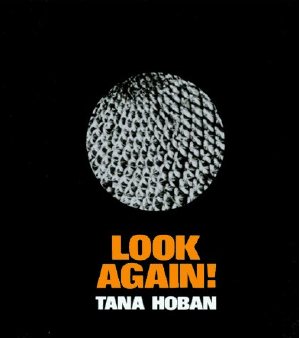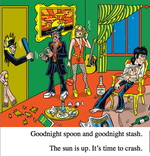 Worlds converge, and now maybe I can close some of the twenty-odd browser tabs that I've accumulated. The topics: children's books with photographs instead of illustrations, why our current parenting environment is the way it is, and how different it really is for us compared to the generations of parents who have come before.
Worlds converge, and now maybe I can close some of the twenty-odd browser tabs that I've accumulated. The topics: children's books with photographs instead of illustrations, why our current parenting environment is the way it is, and how different it really is for us compared to the generations of parents who have come before.
I complained about the lack of children's photo books. Dutch mentioned Tana Hoban, a prolific photographer in the 1940's and 50's whose pictures of children were included in Edward Steichen's landmark 1955 exhibition at MoMA, "The Family of Man." Beginning in 1970 with the publication of Shapes & Things, followed by Look Again in 1971, Hoban developed an innovative, entertaining photographic language for little kids that introduced them to objects, shapes, textures, patterns, numbers, and colors. [Search for Tana Hoban books on Amazon.]
The influence/legacy of Hoban's nearly 50 children's titles can be seen in both ubiquitous series like the I Spy books and DK's primary-colored My First Book Of Whatever series, which float stock photos of everyday whatever on a featureless background, and in "world around you" books like Stephen T. Johnson's Alphabet City from 1999 [and, for that matter, in artistically superior books like Dutch's own street art ABC collection, Persona Urbanae].
Hoban began her children's book series after what she called her "Bank Street Experience":
"Children of the Bank Street School in New York one day were questioned about what they saw on their journey in coming to school. Most of them replied, 'Nothing.' That's when Tana Hoban decided to make pictures that encourage children to watch the world differently all around them and to invita another look at their daily lives.Which should have served as a wakeup call for circa 1970 Bank Street. The legendary and influential teacher's school and educational research center was founded in the 1920's by Lucy Sprague Mitchell, a pioneer in everything from progressive educational theory, to women's rights and work-life balance to children's literature. [The NY Times reviewed the first biography of Mitchell, published only in 1987. The book, by Joyce Antler, is out of print and starts at just $3 on Amazon.] At least if she'd invented a library filing system, she'd have the name recognition of her mentor John Dewey. In 2000, the journal Childhood Education still had to title their article, "Who was Lucy Sprague Mitchell...and why should you know?"
Though Bank Street was later instrumental in the establishment of Head Start, it was Mitchell's impact on children's literature that'll be most familiar to parents. In 1916, Mitchell founded Bank Street's awesomely named predecessor, the Bureau of Educational Experiments to study and observe how children actually develop and learn. From Childhood Education:
Staff at the Bureau studied children's spontaneous use of language. These studies convinced Lucy that children use language not only for communication, but also simply to enjoy its rhythm and quality of sound. She feared that adults could deprive children of this spontaneous enjoyment of language by forcing premature compliance with standard adult forms of speech (Mitchell, 1927), or by exposing them to children's stories that were too abstract:Children do not find the unusual piquant until they are firmly acquainted with the usual. They do not find the preposterous humorous until they have intimate knowledge of ordinary behavior. They do not get the point of alien environments until they are securely oriented in their own. (Conference on Environment and Children, 1971, p. 71)Her most significant book for children, the Here and Now Story Book, grew out of these convictions. Using ideas gleaned from the Bureau's vast records, she penned stories derived from children's actual experiences, such as stories about children involved in block building.Traditionalists preferred stories for children to be based on either information or fantasy-styles Lucy Mitchell referred to as "spinach" or "extreme magic" (Mitchell, 1953). Consequently, the Here and Now Story Book received mixed reviews; yet, Mitchell was not deterred. As she later stated:
One of my chief reasons for publishing this book was the hope of interesting teachers and parents to listen to the language of small children with ears that heard its freshness and beauty instead of merely its immaturities. Such listening I was sure would ... inevitably change the way they replied to the children.(Mitchell, 1953, p. 287)
 After WWII, Mitchell established the Bank Street Writers Laboratory in order to train "a generation of Here and Now authors" creating "literature rooted not in Romantic fancy or an obscure folkloric past but in the child's own everyday surroundings and experiences." At least that's how it was described by the Times in 1987, on the occasion of the 40th anniversary of the Here and Now school's two most famous members' best-selling book: Margaret Wise Brown and Clement Hurd's Goodnight, Moon.
After WWII, Mitchell established the Bank Street Writers Laboratory in order to train "a generation of Here and Now authors" creating "literature rooted not in Romantic fancy or an obscure folkloric past but in the child's own everyday surroundings and experiences." At least that's how it was described by the Times in 1987, on the occasion of the 40th anniversary of the Here and Now school's two most famous members' best-selling book: Margaret Wise Brown and Clement Hurd's Goodnight, Moon.Clement Hurd was told about an 18-month-old who, following one evening's fifth and final run-through, stood up in bed and gazed intently at the book that lay open before him. Placing first one foot squarely on the page - the last double spread of the darkening room - then the other foot, he had paused, then burst into tears. Looking on, the boy's mother realized after a long moment that the child wanted to climb inside the room.I don't know much about philosophy or the French I took, but the story of not being able to climb into the book rings true around here. When she was one or so, and she'd had a few balloons, the kid would try to grab the strings of the balloons in her DK My First Counting Book--photographs of balloons, that is. When she couldn't get them, she'd just completely lose it. It got to be that just opening the book with the unattainable balloons was enough to start her sobbing [a few months ago, the kid even started crying again when my wife told her the story of when she was little.] The power here is obviously not photo vs illustration, but the kid's world around her. Balloons and books and crayon drawings are part of that world; a TV screen is part of that world; a train or car window is part of that world. If you take your kid to Star Wars conventions, droids are part of that world. If you take your kid to football games, Cheeseheads are part of that world. Which makes me wonder if Mitchell's Here and Now is based on an outdated dichotomy between "fairy tale/fantasy" and the kid's "real world"? Or no, maybe it's the other way around, and the out-of-touch fantasies in a corporate hog factory era are all those treacly books about farm animals, and every damn alphabet where N is for something a kid never sees--say, a Nest instead of Ninja.Such stories testify to the uncommon intensity with which children (and, one suspects, more than a few of their elders) continue to be touched by this simple-seeming book about what the French philosopher Gaston Bachelard called the ''human being's first world'' - one's home...
[Interestingly, after all these years, Bank Street just inaugurated The Center for Children's Literature to counteract what they see as "the diminishing use of children's literature in literacy programs, and the increase in the use of dull materials that stress rote and repetition, particularly in the early grades." The first Lifetime Achievement Award went to that unsung hero of kidlit, Eric Carle. Go figure, they're also involved in the production of Jojo's Circus.]
That Times Goodnight Moon article [which is finally freely available after the paper threw open its online archives] had another bit of info that made me think that books don't only reflect kids' Here and Now, but parents' There and Back When:
The book was published in the fall of 1947, for the most part to highly favorable reviews, and with respectable sales that have steadily increased. THEY have risen sharply in the 1980's.OK, let's ignore the idea that reading a book to a child is a "present trend"--or was in 1987. The real story is the link between Baby Boomer parents' childhood memories and the book's 80's sales spike. At 200,000 copies a year by 1987, it's safe to assume that half of Goodnight, Moon's sales to that point came in the 80's. As of 2005, the book was clocking 800,000 copies a year, by the way; all those Boomer grandparents, I guess, plus the rest of us who came of age and inherited the Boomer's parenting culture.Harper & Row reported sales last year of 89,100 in hard cover and 120,000 in paperback, for a total of slightly more than two million since publication -making it one of the most popular of Brown's more than 90 books for young children. The publisher ascribes the current sales to new parents remembering the book from their own childhoods, and the present trend of reading aloud to infants and very young children.
How much of what's considered "traditional" or "classic" or even "the way it is and always has been" is actually based on the memories and experience of a particular generations' own childhoods, or even better/worse, is completely arbitrary?




One book of photos I love showing my son is George Nelson's "How To See". While it isn't designed for children it does provide a wonderful 'map' to how the western world interprets things.
Nina Crews's excellent Neighborhood Mother Goose and to a lesser extent Mo Willems's Knuffle Bunny do a really nice job of contextualizing their stories with photos of what a kid in Brooklyn might see on the walk to and fron school.
HATE Goodnight, Moon.